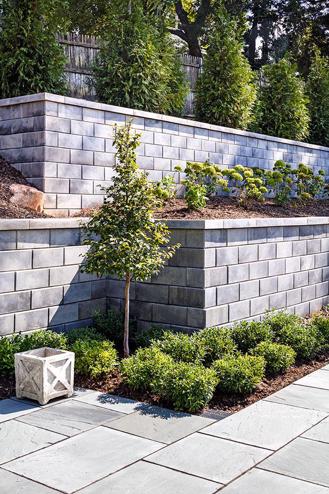Retaining Wall And Garden Wall Construction Fundamentals Explained
Table of ContentsThe Ultimate Guide To Retaining Wall And Garden Wall ConstructionUnknown Facts About Retaining Wall And Garden Wall ConstructionThe Retaining Wall And Garden Wall Construction IdeasRetaining Wall And Garden Wall Construction Fundamentals Explained
If this slope is not regulated, the wall surface will relocate or stop working. Rain that runs the top of a maintaining wall surface can damage the dirt and also plants on either side, eroding them away. Water drainage systems divert this water from at risk locations, reducing the influence to the structure and also its environments.It's been stated half of all the issues with retaining wall surfaces involve drainage and also water problems, and also maintaining water out of these wall surfaces is a large one. If it's completely dry, there's little to no possibility any type of plant life can take hold - Retaining Wall And Garden Wall Construction. An effectively made as well as set up system will certainly maintain your wall surface dry, conserving you cash on maintenance and replacement expenses.
All preserving walls ought to include water drainage stone also if a draining pipes pipe is not needed. Area filter textile over the water drainage rock as well as below the topsoil. That avoids great material and also natural issue from blocking up the drain rock.

Some Known Questions About Retaining Wall And Garden Wall Construction.
This damages can be costly to repair, and also a properly installed drainpipe would certainly have prevented it (Retaining Wall And Garden Wall Construction).

A keeping wall that preserves soil on the backside and water on the frontside is called a seawall or a bulkhead. A keeping wall is designed to hold in location a mass of planet or the like, such as the side of a balcony or excavation. The structure is built to withstand the lateral stress of soil when there is a wanted modification in ground altitude that surpasses the angle of repose of the soil.

These are cantilevered from a ground as well as surge above the grade on one side to preserve a higher level quality on the contrary side. Retaining Wall And Garden Wall Construction.
More About Retaining Wall And Garden Wall Construction
This reduction lowers the pressure on the keeping navigate here wall. One of the most essential consideration in appropriate layout and installment of keeping walls is to read this identify as well as counteract the propensity of the preserved product to move downslope as a result of gravity. This creates lateral earth stress behind the wall surface which depends upon the angle of inner rubbing (phi) and the cohesive stamina (c) of the retained material, along with the direction as well as magnitude of activity the keeping structure goes through.
Various types of preserving walls Building sorts of gravity preserving walls Gravity walls depend upon their mass (rock, concrete or various other heavy product) to resist stress from behind and may have a 'batter' setback to boost security by leaning back toward the kept dirt. For short landscape design walls, they are commonly made from mortarless rock or segmental concrete systems (stonework systems).
Diaphragm wall surfaces are costly walls, yet they save time as well as area, and therefore are used in metropolitan buildings. Sheet stack keeping walls are normally used in soft soil and limited areas.
For a quick price quote the material is generally driven 1/3 over ground, 2/3 underground, however this may be modified depending upon the atmosphere. Taller view sheet stack walls will certainly need a tie-back support, or "dead-man" positioned in the dirt a distance behind the face of the wall, that is connected to the wall surface, typically by a wire or a rod.
The Single Strategy To Use For Retaining Wall And Garden Wall Construction
A secured preserving wall can be built in any of the abovementioned designs but additionally consists of additional stamina making use of cables or various other stays anchored in the rock or dirt behind it. Usually driven into the product with boring, anchors are after that broadened at the end of the wire, either by mechanical methods or usually by infusing pressurized concrete, which increases to form a light bulb in the dirt.